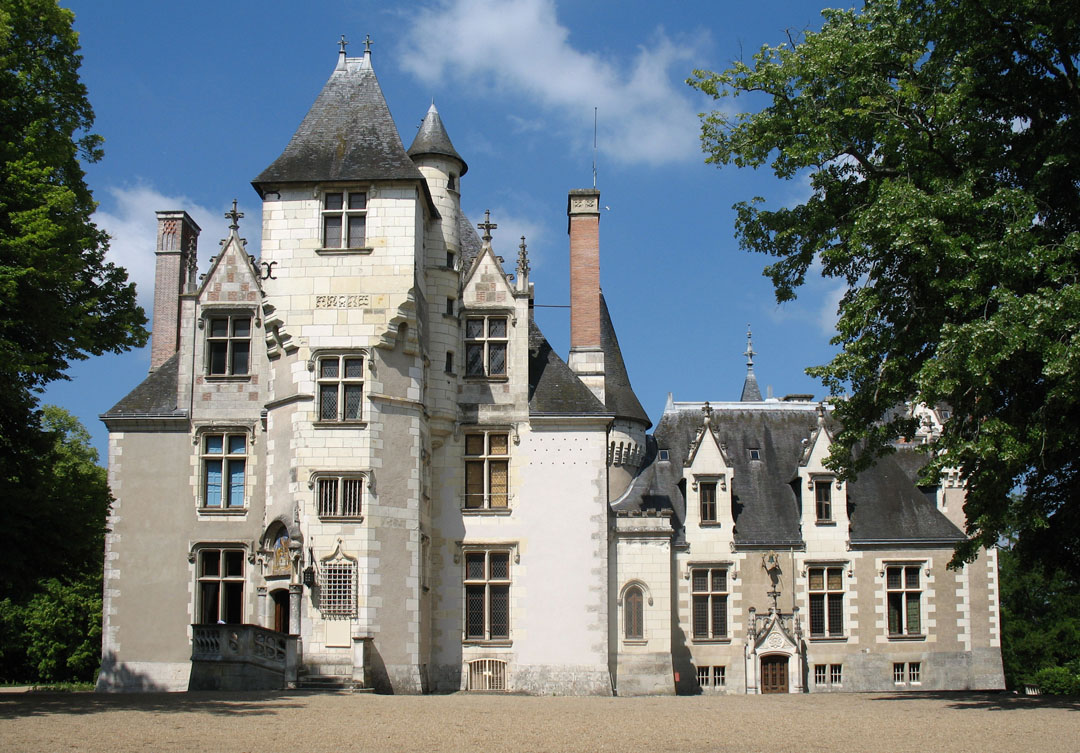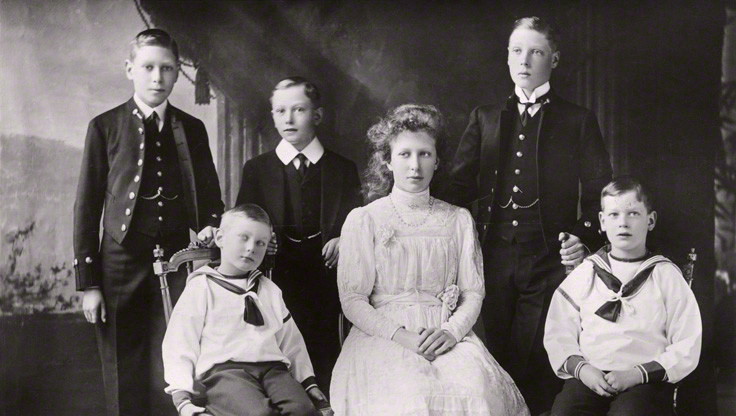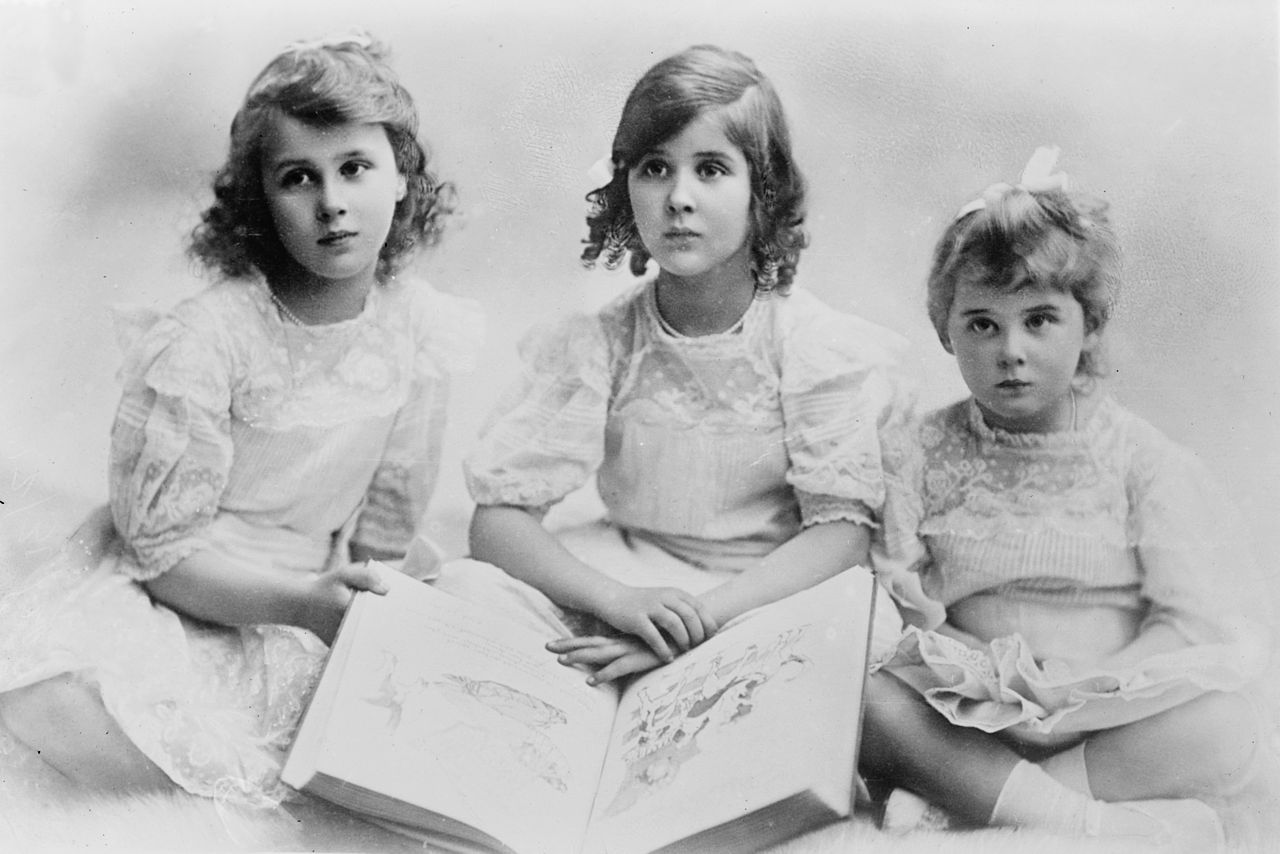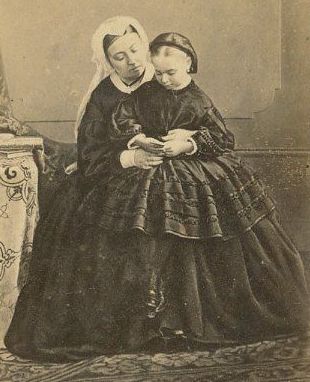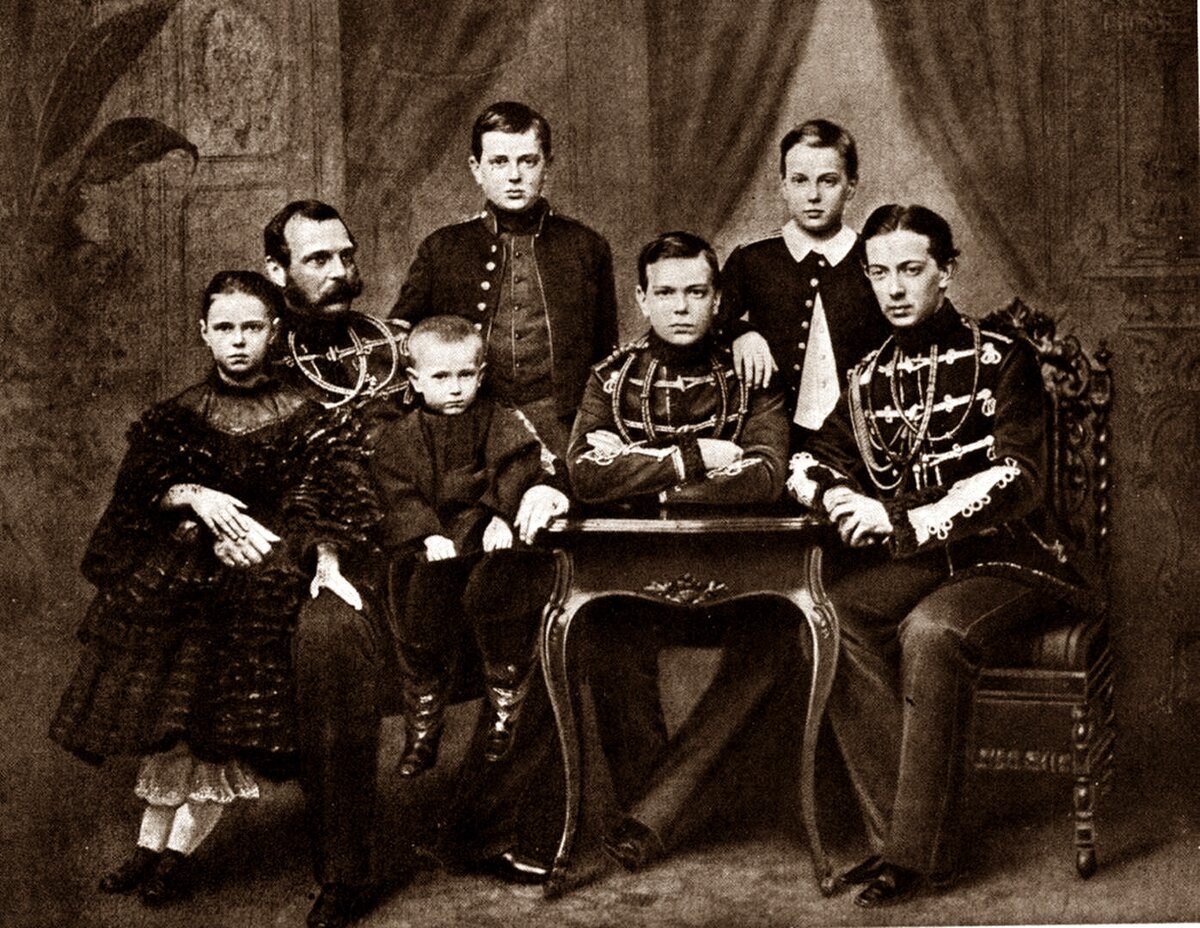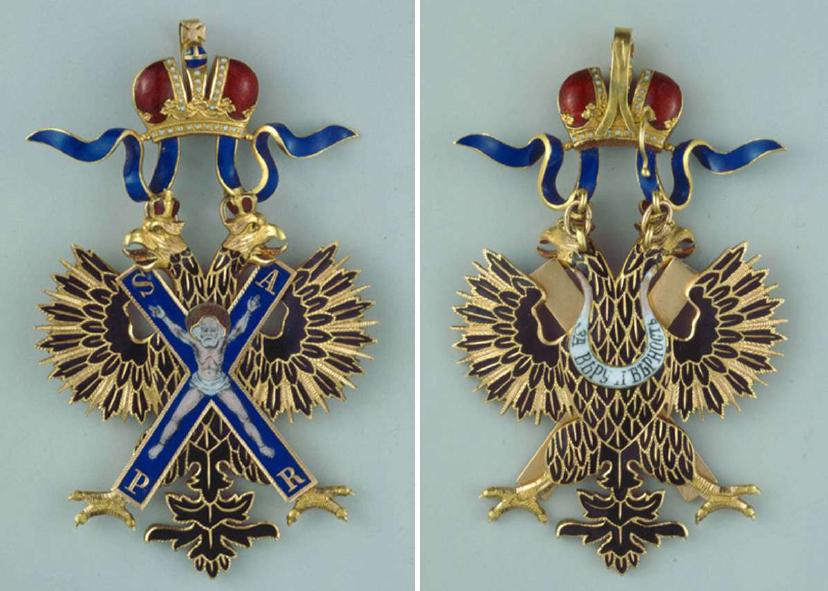by Susan Flantzer © Unofficial Royalty 2019

King Christian IX with his family in the Garden Hall of Fredensborg Palace in 1883 by Laurits Tuxen; Credit – Wikipedia
King Christian IX of Denmark and Princess Louise of Hesse-Kassel had six children and 39 grandchildren. Their grandchildren sat upon the thrones of Denmark, Greece, Norway, Russia, and the United Kingdom. They are the ancestors of six of the ten current European monarchs: King Philippe of Belgium, King Frederik X of Denmark, Grand Duke Henri of Luxembourg, King Harald V of Norway, King Felipe VI of Spain, King Charles III of the United Kingdom, and two former monarchs, the late King Michael of Romania and the late King Constantine II of Greece. See Wikipedia: Monarchs descended from King Christian IX.

King Christian IX and his family in 1862 (Front: Dagmar, Valdemar, Queen Louise, Thyra, Alexandra; Back: Frederik, King Christian, Vilhelm); Credit – Wikipedia
However, King Christian IX of Denmark was not born destined to be a king. King Christian IX was born a German prince, the sixth child and fourth son of Friedrich Wilhelm, Duke of Schleswig-Holstein-Sonderburg-Glücksburg and Princess Louise Caroline of Hesse-Kassel, on April 8, 1818, at Gottorp Castle near the town of Schleswig in the Duchy of Schleswig, now in Germany.
Christian married his second cousin Princess Louise of Hesse-Kassel, the daughter of Prince Wilhelm of Hesse-Kassel and Princess Charlotte of Denmark. Both Christian and Louise were great-grandchildren of King Frederik V of Denmark. Their descent from King Frederik V are below.
King Frederik V of Denmark married Princess Louisa of Great Britain (1st wife) → Princess Louise of Denmark married Prince Charles of Hesse-Kassel → Princess Louise Caroline of Hesse-Kassel married Friedrich Wilhelm, Duke of Schleswig-Holstein-Sonderburg-Glücksburg → King Christian IX of Denmark
King Frederik V of Denmark married Duchess Juliana Maria of Brunswick-Wolfenbüttel (2nd wife) → Frederik, Hereditary Prince of Denmark married Duchess Sophia Frederica of Mecklenburg-Schwerin → Princess Charlotte of Denmark married Prince Wilhelm of Hesse-Kassel → Louise of Hesse-Kassel
So how did Christian become King of Denmark? When King Christian VIII, the son of Frederik, Hereditary Prince of Denmark, died in 1848, he was succeeded by his son, King Frederik VII, who had married three times but had no children, resulting in a succession crisis. Louise, Christian IX’s wife, had lived in Denmark from the time she was three years old. She was a niece of King Christian VIII of Denmark and a closer heir than her husband. Women could inherit the Danish throne only if there were no male heirs (Semi-Salic Law), and Louise and her mother Charlotte of Denmark rescinded their succession rights to Christian, Louise’s husband, in 1851. The Act of Succession of 1853 officially made Christian the heir of King Frederik VII, and he became king in 1863 when King Frederik VII died.
Christian IX and his wife Louise were as much the “Grandparents of Europe” as were Queen Victoria and Prince Albert. Christian and Louise had 39 grandchildren, and their grandsons included Nicholas II, Emperor of All Russia, King Constantine I of Greece, King George V of the United Kingdom, King Christian X of Denmark, and King Haakon VII of Norway. Over the years, numerous large family reunions were held at Fredensborg Palace in Denmark with children, in-laws, grandchildren, and great-grandchildren.
A story has been told about King Christian IX. Whether it is true or not, it illustrates his relationship with other European monarchies:
One day, Christian IX and his son Vilhelm (George I of Greece) and the husbands of two of his daughters (Alexander III of Russia and the Prince of Wales, the future Edward VII of the United Kingdom) went for a walk. They encountered a country gentleman who wondered who they were, thinking they were guests of some local squire. “I am your king,” explained Christian. “This is my son, the King of Greece, and this is my son-in-law, the Emperor of Russia, and my other son-in-law, the Prince of Wales.” The man was not impressed and said, “All right, I’ll tell you who I am. I am Jesus Christ!”
********************
King Christian IX’s children, grandchildren, and great-grandchildren are listed below. In addition, notable great-great-grandchildren and great-great-great-grandchildren are also included. Monarchs and consorts from former monarchies and current monarchies, along with current heirs, who are King Christian’s descendants, are in bold. The links below are either from Unofficial Royalty or Wikipedia. Not all people have Wikipedia links.

Frederik VIII and his wife with their four eldest children by Elfelt, bromide postcard print, (circa 1877), NPG x74398 © National Portrait Gallery, London
1) King Frederik VIII of Denmark (1843-1912) married (1869) Princess Louise of Sweden (1851-1926), had four sons and four daughters
- King Christian X of Denmark (1870-1947) married (1898) Duchess Alexandrine of Mecklenburg-Schwerin (1879-1952), had two sons
- King Frederik IX of Denmark married (1935) Princess Ingrid of Sweden (1910-2000), had three daughters
- Notable Great-Great-Grandchild: Queen Margrethe II of Denmark (born 1940) married (1967) Henri de Laborde de Monpezat (1934-2018), had two sons
- Notable Great-Great-Great-Grandchild: King Frederik X of Denmark (born 1968) married (2004) Mary Donaldson, had two sons and two daughters
- Notable Great-Great-Grandchild: Princess Anne-Marie of Denmark, Queen of Greece (born 1946) married (1964) King Constantine II of Greece (1940 – 2023), had three sons and two daughters
- Notable Great-Great-Grandchild: Queen Margrethe II of Denmark (born 1940) married (1967) Henri de Laborde de Monpezat (1934-2018), had two sons
- Knud, Hereditary Prince of Denmark (1900-1976) married (1933) his first cousin Princess Caroline-Mathilde of Denmark (1912-1995), had one daughter and two sons
- King Frederik IX of Denmark married (1935) Princess Ingrid of Sweden (1910-2000), had three daughters
- Prince Carl of Denmark, later King Haakon VII of Norway (1872-1957) married his first cousin Princess Maud of Wales (1869-1938), had one son
- Prince Alexander of Denmark, later King Olav V of Norway (1903-1991), married (1929) Princess Märtha of Sweden (1901-1954), had two daughters and one son
- Notable Great-Great-Grandchild: King Harald V of Norway (born 1937), married (1968) Sonja Haraldsen (born 1937), had two children
- Notable Great-Great-Great-Grandchild: Crown Prince Haakon of Norway (born 1973) married (2001) Mette-Marit Tjessem Høiby, (born 1973), had two children
- Notable Great-Great-Grandchild: King Harald V of Norway (born 1937), married (1968) Sonja Haraldsen (born 1937), had two children
- Prince Alexander of Denmark, later King Olav V of Norway (1903-1991), married (1929) Princess Märtha of Sweden (1901-1954), had two daughters and one son
- Princess Louise of Denmark (1875-1906) married (1896) Prince Frederick of Schaumburg-Lippe (1868-1945), had two daughters and one son
- Princess Marie Louise of Schaumburg-Lippe (1897-1938), married (1916) Prince Friedrich Sigismund of Prussia (1891-1927), had one son and one daughter
- Prince Christian of Schaumburg-Lippe (1898-1974), married (1937) his first cousin Princess Feodora of Denmark (1910-1975), had three sons and one daughter
- Princess Stephanie of Denmark (1899-1925) married (1921) Viktor Adolf, 5th Prince of Bentheim und Steinfurt (1883-1961), had two sons, died in childbirth along with twin sons
- Prince Harald of Denmark (1876-1949) married (1909) Princess Helena Adelaide of Schleswig-Holstein-Sonderburg-Glücksburg (1888-1962), had three daughters and two sons
- Princess Feodora of Denmark (1910-1975) married (1937) her first cousin Prince Christian of Schaumburg-Lippe (1898-1974), had three sons and one daughter
- Princess Caroline-Mathilde of Denmark (1912-1995) married her first cousin, Knud, Hereditary Prince of Denmark (1900-1976), had one daughter and two sons
- Princess Alexandrine-Louise of Denmark (1914-1962) married Count Luitpold of Castell-Castell (1904-1941), had two daughters and one son
- Prince Gorm of Denmark (1919-1991), unmarried
- Count Oluf of Rosenborg (1923-1990), born Prince Oluf of Denmark, after marrying without the monarch’s consent, he lost his succession rights and his royal style and title, married (1) (1948) Annie Puggard-Müller (1926-2013), had one son and one daughter, divorced (1977), married (2) (1982) Lis Wolf-Jürgensen (born 1935), no children, divorced
- Princess Ingeborg of Denmark (1878-1958) married (1897) Prince Carl of Sweden, Duke of Västergötland (1861-1951), had three daughters and one son
- Princess Margaretha of Sweden (1899-1977) married (1919) Prince Axel of Denmark (1888-1964), had two sons
- Princess Märtha of Sweden, Crown Princess of Norway (1901–1954) married (1929) King Olav V of Norway (1903-1991), had two daughters and one son
- Notable Great-Great-Grandchild: King Harald V of Norway (born 1937), married (1968) Sonja Haraldsen (born 1937), had one daughter and one son
- Notable Great-Great-Great-Grandchild: Crown Prince Haakon of Norway (born 1973) married (2001) Mette-Marit Tjessem Høiby (1973), had two children
- Notable Great-Great-Grandchild: King Harald V of Norway (born 1937), married (1968) Sonja Haraldsen (born 1937), had one daughter and one son
- Princess Astrid of Sweden, Queen of the Belgians (1905–1935, died in a car accident) married (1926) Leopold III, King of the Belgians (1901-1983), had one daughter and two sons
- Notable Great-Great-Grandchild: Princess Joséphine Charlotte, Grand Duchess of Luxembourg (1927-2005) married (1953) Grand Duke Jean of Luxembourg (1921-2019)
- Notable Great-Great-Great-Grandchild: Grand Duke Henri of Luxembourg (born 1955) married (1981) María Teresa Mestre y Batista (born 1956), had four sons and one daughter
- Notable Great-Great-Grandchild: Baudouin, King of the Belgians (1930-1993), married Fabiola de Mora y Aragón (1928-2014), no children
- Notable Great-Great-Grandchild: Albert II, King of the Belgians (born 1934), married Paola Ruffo di Calabria (born 1937), had two sons and one daughter
- Notable Great-Great-Great-Grandchild: Philippe, King of the Belgians (born 1960), married Mathilde d’Udekem d’Acoz (born 1973), had two daughters and two sons
- Notable Great-Great-Grandchild: Princess Joséphine Charlotte, Grand Duchess of Luxembourg (1927-2005) married (1953) Grand Duke Jean of Luxembourg (1921-2019)
- Prince Carl Bernadotte (1911-2003), born Prince Carl of Sweden, Duke of Östergötland, due to an unequal marriage, he lost his succession rights and his royal title and style, married (1) (1937) Countess Elsa von Rosen (1904–1991), had one daughter, divorced (1951), married (2) (1954) Ann Margareta Larsson (1921–1975), no children, divorced (1961), married (3) (1978) Kristine Rivelsrud (1932-2014), no children
- Princess Thyra of Denmark (1880-1945), unmarried
- Prince Gustav of Denmark (1887-1944), unmarried
- Princess Dagmar of Denmark (1890-1961) married (1922) Jørgen Castenskjold (1893-1978), had four sons and one daughter
- Carl Castenskjold (1923-2006), married (1948) Bente Grevenkop (1927-2003), had two sons and one daughter, divorced (1963)
- Christian Ludwig Castenskjold (born 1926) married (1952) Cecily Abbots (1927-2019), had one daughter
- Jørgen Castenskjold (1928-1964), married (1) (1956) Kirsten Schlichtkrull (born 1934), had one daughter, divorced (1958), married (1959) (2) Birgit Tengstedt (born 1932), had one daughter
- Dagmar Castenskjold (1930-2013), married (1950) Poul Bitsch (1930-1967), had three sons
- Christian Frederik Castenskjold (1931-1937), died in childhood
********************
Embed from Getty Images
Alexandra and her husband with their children, circa 1880
2) Princess Alexandra of Denmark (1844 – 1925) married (1863) King Edward VII of the United Kingdom (1841 – 1910), had three sons and three daughters
- Prince Albert Victor, Duke of Clarence and Avondale (1864-1892), unmarried
- King George V of the United Kingdom (1865-1936) married (1893) Princess Victoria Mary of Teck (1867-1953), had five sons and one daughter
- King Edward VIII of the United Kingdom (Duke of Windsor after his abdication) (1894-1972), married (1937) Wallis Simpson (1896-1986), no children
- King George VI of the United Kingdom (1895-1952), married (1923) Lady Elizabeth Bowes-Lyon (1900-2002), had two daughters
- Notable Great-Great-Grandchild: Queen Elizabeth II of the United Kingdom (1926-2022) married (1947) Prince Philip of Greece (1921-2021), had three sons and one daughter
- Notable Great-Great-Great-Grandchild: King Charles III of the United Kingdom, (born 1948), married (1) (1981) Lady Diana Spencer, had two sons, divorced; married (2) (2005) Camilla Shand Parker-Bowles, no children
- Notable Great-Great-Grandchild: Queen Elizabeth II of the United Kingdom (1926-2022) married (1947) Prince Philip of Greece (1921-2021), had three sons and one daughter
- Mary, Princess Royal, Countess of Harewood (1897-1965), married (1922) Henry Lascelles, 6th Earl of Harewood (1882-1947), had two sons
- Prince Henry, Duke of Gloucester (1900-1974), married (1935) Lady Alice Montagu Douglas Scott (1901-2004), had two sons
- Prince George, Duke of Kent, (1902-1942), married (1934) Princess Marina of Greece (1906-1968), had two sons and one daughter
- Prince John of the United Kingdom (1905-1919), died due to epilepsy complications
- Princess Louise, Princess Royal (1867-1931) married (1889) Alexander Duff, 1st Duke of Fife (1849-1912), had two daughters
- Princess Alexandra, 2nd Duchess of Fife (1891-1959), married (1913) her first cousin once removed, Prince Arthur of Connaught, (1883-1938), had one son
- Princess Maud of Fife (1893-1945), married (1923) Charles Carnegie, 11th Earl of Southesk (1893-1992), had one son
- Princess Victoria of the United Kingdom (1868-1935), unmarried
- Princess Maud of Wales, Queen of Norway (1869-1938) married (1896) her first cousin Prince Carl of Denmark, later King Haakon VII of Norway (1872-1957), had one son
- Prince Alexander of Denmark, later King Olav V of Norway (1903-1991), married (1929) Princess Märtha of Sweden (1901-1954), had two daughters and one son
- Notable Great-Great-Grandchild: King Harald V of Norway (born 1937), married (1968) Sonja Haraldsen, had one daughter and one son
- Notable Great-Great-Great-Grandchild: Crown Prince Haakon of Norway (born 1973) married (2001) Mette-Marit Tjessem Høiby (born 1973), had two children
- Notable Great-Great-Grandchild: King Harald V of Norway (born 1937), married (1968) Sonja Haraldsen, had one daughter and one son
- Prince Alexander of Denmark, later King Olav V of Norway (1903-1991), married (1929) Princess Märtha of Sweden (1901-1954), had two daughters and one son
- Prince Alexander John of Wales (1871), born prematurely, died the next day
********************

King George and Queen Olga with six of their children, circa 1890; Credit – Wikipedia
3) Prince Vilhelm of Denmark, later King George I of Greece (1845–1913) married (1867) Grand Duchess Olga Konstantinovna of Russia (1851-1926), had five sons and three daughters
Male-line descendants below of King Christian IX of Denmark, who also held the title Prince or Princess of Greece, also held the title of Prince or Princess of Denmark and are traditionally referred to as Prince or Princess of Greece and Denmark.
- King Constantine I of Greece (1868-1923) married (1889) Princess Sophie of Prussia (1870-1932), had three sons and three daughters
- King George II of Greece (1890-1947), married (1921) Princess Elisabeta of Romania (1894-1956), no children, divorced
- King Alexander of Greece (1893-1920), married (1919) Aspasia Manos (1896-1972), had one daughter
- Notable Great-Great-Grandchild: Princess Alexandra of Greece, Queen of Yugoslavia (1921-1993) married (1944) King Peter II of Yugoslavia (1923-1970), had one son
- Princess Helen of Greece, Queen Mother of Romania (1896-1982), married (1921) King Carol II of Romania (1893-1953), had one son, divorced
- Notable Great-Great-Grandchild: King Michael (Mihai) of Romania (1921-2017), married (1948) Princess Anne of Bourbon-Parma (1923-2016), had five daughters
- King Paul I of Greece (1901-1964), married (1938) Princess Frederica of Hanover (1917-1981), had two daughters and one son
- Notable Great-Great-Grandchild: Princess Sophia of Greece, Queen Sofia of Spain (born 1938) married (1962) King Juan Carlos I of Spain (born 1938), had two daughters and one son
- Notable Great-Great-Great-Grandchild: King Felipe VI of Spain (born 1968) married (2004) Letizia Ortiz Rocasolano (born 1972), had two daughters
- Notable Great-Great-Grandchild: King Constantine II of Greece (born 1940) married (1964) Princess Anne-Marie of Denmark (born 1946), had three sons and two daughters
- Notable Great-Great-Grandchild: Princess Sophia of Greece, Queen Sofia of Spain (born 1938) married (1962) King Juan Carlos I of Spain (born 1938), had two daughters and one son
- Princess Irene of Greece, Duchess of Aosta (1904-1974), married (1939) Prince Aimone, Duke of Aosta (1900-1948), had one son
- Princess Katherine of Greece, The Lady Katherine Brandram (1913-2007), married (1947) Major Richard Brandram (1911-1994), had one son
- Prince George of Greece (1869-1957) married (1907) Princess Marie Bonaparte (1882-1962), had one son and one daughter
- Prince Peter of Greece (1908–1980) married (1939) Irina Aleksandrovna Ovtchinnikova (1904-1990), no children
- Princess Eugénie of Greece (1910–1988) married (1) (1938) Prince Dominic Radziwill (1911-1976), had one son and one daughter, divorced, married (2) (1949) Prince Raymundo della Torre e Tasso, Duke of Castel Duino, had one son, divorced
- Princess Alexandra of Greece, Grand Duchess Alexandra Georgievna of Russia (1870-1891) married Grand Duke Paul Alexandrovich of Russia (1860-1919, killed by the Bolsheviks), had one daughter and one son
- Grand Duchess Maria Pavlovna (1890–1958), married (1) (1908) Prince Wilhelm of Sweden, Duke of Södermanland (1884-1965) had one son, divorced, married (2) (1917) Prince Sergei Mikhailovich Putyatin (1893–1966), had one son
- Grand Duke Dmitri Pavlovich (1891–1942), married morganatically (1926) Audrey Emery (1904-1971), had one son, divorced, Dmitri was one of the assassins of Grigori Rasputin
- Prince Nicholas of Greece (1872-1938) married (1902) Grand Duchess Elena Vladimirovna of Russia (1882-1957), had three daughters
- Princess Olga of Greece (1903–1997) married (1923) Prince Paul of Yugoslavia (1893-1976), had two sons and one daughter
- Princess Elizabeth of Greece (1904–1955) married (1934) Count Carl Theodor of Toerring-Jettenbach (1900-1967), had one son and one daughter
- Princess Marina of Greece (1906-1968) married (1934) Prince George, Duke of Kent (1902-1942), had two sons and one daughter
- Notable Great-Great-Grandchild: Prince Edward, Duke of Kent (born 1935), married (1961) Katharine Worsley (born 1933), had two sons and one daughter
- Notable Great-Great-Grandchild: Princess Alexandra of Kent (born 1936), married (1963) The Honorable Angus Ogilvy (1928-2004), had one son and one daughter
- Notable Great-Great-Grandchild: Prince Michael of Kent (born 1942), married (1978) Baroness Marie-Christine von Reibnitz (born 1945), had one son and one daughter
- Princess Maria of Greece (1876-1940) married (1) (1900) Grand Duke George Mikhailovich of Russia (1863-1919, killed by the Bolsheviks), had two daughters, married (2) (1922) Admiral Perikles Ioannidis (1881-1965), no children
- Princess Nina Georgievna of Russia (1901-1974) married (1922) Prince Paul Chavchavadze (1899–1971), had one son
- Princess Xenia Georgievna of Russia (1903-1965) married (1) (1921) William Bateman Leeds, Jr., had one daughter, divorced, married (2) (1946) Herman Jud (1911-1987), no children
- Princess Olga of Greece (born and died 1880)
- Prince Andreas of Greece (1882-1944), married (1903) Princess Alice of Battenberg (1885-1969), had four daughters and one son
- Princess Margarita of Greece (1905-1981) married (1931) Gottfried, Prince of Hohenlohe-Langenburg (1897-1960), had four sons and one daughter
- Princess Theodora of Greece (1906-1969) married (1931) Berthold, Margrave of Baden (1906-1963), had one daughter and two sons
- Princess Cecilie of Greece (1911-1937) married (1931) Georg Donatus, Hereditary Grand Duke of Hesse and by Rhine (1906-1937), had two sons and one daughter
- Princess Sophie of Greece (1914-2001) married (1) (1930) Prince Christoph of Hesse, (1901-1943, killed in World War II), had three daughters and two sons, married (2) (1946) Prince Georg Wilhelm of Hanover, (1915-2006), had two sons and one daughter
- Prince Philip of Greece, Duke of Edinburgh (1921-2021) married (1947) Queen Elizabeth II of the United Kingdom (1926 -2022), had three sons and one daughter
- Notable Great-Great-Grandchild: King Charles III of the United Kingdom (born 1948), married (1) (1981) Lady Diana Spencer, had two sons, divorced; married (2) (2005) Camilla Shand Parker-Bowles, no children
- Prince Christopher of Greece (1888-1940) married (1) (1920) Nancy Stewart Worthington Leeds (1878-1923), no children; married (2) (1929) Princess Françoise of Orléans (1902-1953), had one son
- Prince Michael of Greece (born 1939), married (1965) Marina Karella (born 1940), had two daughters
********************

Empress Maria Feodorovna and her husband with their five surviving children; Credit – Wikipedia
4) Princess Dagmar of Denmark, Maria Feodorovna, Empress of All Russia (1847-1928), married (1866) Alexander III, Emperor of All Russia (1845–1894), had four sons and two daughters
- Nicholas II, Emperor of All Russia (1868-1918), married (1894) Princess Alix of Hesse and by Rhine (1872-1918), had four daughters and one son, the entire family was killed by the Bolsheviks in 1918
- Grand Duchess Olga Nikolaevna of Russia (1895-1918)
- Grand Duchess Tatiana Nikolaevna of Russia (1897-1918)
- Grand Duchess Maria Nikolaevna of Russia (1899-1918)
- Grand Duchess Anastasia Nikolaevna of Russia (1901-1918)
- Tsesarevich Alexei Nikolaevich of Russia (1904-1918)
- Grand Duke Alexander Alexandrovich of Russia (1869-1870), died young of meningitis
- Grand Duke George Alexandrovich of Russia (1871-1899), unmarried, died of tuberculosis
- Grand Duchess Xenia Alexandrovna of Russia (1875-1960), married (1894) Grand Duke Alexander Mikhailovich of Russia (1866-1933), had one daughter and six sons
- Princess Irina Alexandrovna of Russia (1895-1970), married (1914) Prince Felix Yusupov (1887-1967), was one of the assassins of Grigori Rasputin, had one daughter
- Prince Andrei Alexandrovich of Russia (1897-1981), married (1) (1918) Elisabetta Ruffo-Sasso (1886-1940), had one son and two daughters, married (2) (1842) Nadine McDougall (1908–2000), had one daughter
- Prince Feodor Alexandrovich of Russia (1898-1968), married (1923) Princess Irina Pavlovna Paley (1903-1990), daughter of his mother’s paternal uncle Grand Duke Paul Alexandrovich of Russia and his morganatic wife Princess Olga Paley, had one son, divorced
- Prince Nikita Alexandrovich of Russia (1900-1974), married (1922) Countess Maria Vorontsova-Dashkova (1903-1997), had two sons
- Prince Dmitri Alexandrovich of Russia (1901-1980), married (1) (1931) Countess Marina Sergeyevna Golenischeva-Kutuzova, had one daughter, divorced, married (2) (1954) Margaret Sheila MacKellar, no children
- Prince Rostislav Alexandrovich of Russia (1902-1978), married (1) (1928) Princess Alexandra Pavlovna Galitzine (1905-2006), had one son, divorced, married (2) (1944) Alice Eilken (born 1923), had one son, divorced, married (3) (1954) Hedwig von Chappuis (1905-1997), no children
- Prince Vasili Alexandrovich of Russia (1907-1989), married (1931) Princess Natalia Golitsyna (1907- 1989), had one daughter
- Grand Duke Michael Alexandrovich of Russia (1878-1918, killed by the Bolsheviks in 1918), married (1912) Natalia Sergeyevna Sheremetyevskaya, Countess Brasova (1880-1952), had one child
- George Mikhailovich, Count Brasov (1910-1931), unmarried, died in a car accident
- Grand Duchess Olga Alexandrovna of Russia (1882-1960), married (1) (1901) Duke Peter Alexandrovich of Oldenburg (1868-1924), no children, marriage annulled, married (2) (1916) Nikolai Alexandrovich Kulikovsky (1881-1958), had two sons
- Tikhon Nikolaevich Kulikovsky (1917-1993), married (1) (1942) Agnet Petersen (1920-2006), no children, divorced; married (2) (1959) Livia Sebastian (1922-1982), had one daughter, divorced; married (3) (1986) Olga Nikolaevna Pupynina (born 1926), no children
- Guri Nikolaevich Kulikovsky (1919-1984), married (1) (1940) Ruth Schwartz (1921-2015), had one daughter and two sons, divorced; married (2) Aze Gagarin (1924-2012), no children
********************

Thyra and her husband with their six children; Credit – Wikipedia
5) Princess Thyra of Denmark (1853–1933), married (1878) Crown Prince Ernst August of Hanover, 3rd Duke of Cumberland and Teviotdale (1845-1923), had three sons and three daughters
- Princess Marie Louise of Hanover (1879-1948) married (1900) Prince Maximilian of Baden (1867-1929), had one daughter and one son
- Princess Marie Alexandra of Baden (1902-1944, killed in the bombing of Frankfurt, Germany during World War II), married (1924) Prince Wolfgang of Hesse-Kassel (1896-1989), no children
- Berthold, Margrave of Baden (1906-1963) married (1931) Princess Theodora of Greece (1906-1969), had one daughter and two sons
- Prince Georg Wilhelm of Hanover (1880-1912), unmarried, killed in a car accident
- Princess Alexandra of Hanover, Grand Duchess of Mecklenburg-Schwerin (1882-1963) married (1904) Friedrich Franz IV, Grand Duke of Mecklenburg-Schwerin (1882–1945), had two sons and three daughters
- Hereditary Grand Duke Friedrich Franz of Mecklenburg-Schwerin (1910-2001) married (1941) Karin von Schaper (1920-2012), no children, divorced in 1967, remarried in 1977
- Duke Christian Ludwig of Mecklenburg-Schwerin (1912-1996), married (1954) Princess Barbara of Prussia (1920-1994), had two daughters
- Duchess Olga of Mecklenburg-Schwerin (1916-1917), died in infancy
- Duchess Thyra of Mecklenburg-Schwerin (1919-1981), unmarried
- Duchess Anastasia of Mecklenburg-Schwerin (1923-1979), married (1943) Prince Friedrich Ferdinand of Schleswig-Holstein-Sonderburg-Glücksburg (1913-1989), had four daughters
- Princess Olga of Hanover (1884-1958), unmarried
- Prince Christian of Hanover (1885-1901), died from undiagnosed and untreated appendicitis, which developed into peritonitis
- Ernst August III, Duke of Brunswick (1887-1953), married (1913) Princess Viktoria Luise of Prussia (1892-1980), had four sons and one daughter
- Prince Ernst August IV of Hanover, Hereditary Prince of Brunswick (1914-1987), married (1) (1951) Princess Ortrud of Schleswig-Holstein-Sonderburg-Glücksburg (1925-1980), had three daughters and three sons; married (2) (1981) Countess Monika of Solms-Laubach, no children
- Notable Great-Great-Grandchild: Prince Ernst August V of Hanover (born 1954), married (1) (1981) Chantal Hochuli (born 1955), had two sons, divorced; married (2) (1999) Princess Caroline of Monaco (born 1957), had one daughter
- Prince Georg Wilhelm of Hanover (1915-2006) married (1946) Princess Sophie of Greece (1914-2001), had two sons and one daughter
- Princess Friederike of Hanover, Queen of Greece (1917) married (1938) King Paul of Greece (1901-1964), had two daughters and one son
- Notable Great-Great-Grandchild: Princess Sophia of Greece, Queen Sofia of Spain (born 1938), married (1962) King Juan Carlos I of Spain (born 1938), had two daughters and one son
- Notable Great-Great-Great-Grandchild: King Felipe VI of Spain (born 1968) married (2004) Letizia Ortiz Rocasolano (born 1972), had two daughters
- Notable Great-Great-Grandchild: King Constantine II of Greece (1940-2023) married Princess Anne-Marie of Denmark (born 1946), had three sons and two daughters
- Notable Great-Great-Grandchild: Princess Sophia of Greece, Queen Sofia of Spain (born 1938), married (1962) King Juan Carlos I of Spain (born 1938), had two daughters and one son
- Prince Christian Oscar of Hanover (1919-1981) married (1963) Mireille Dutry (born 1946), had two daughters, divorced
- Prince Welf Heinrich of Hanover (1923-1997) married (1960) Princess Alexandra of Ysenburg and Büdingen (1937-2015), no children
- Prince Ernst August IV of Hanover, Hereditary Prince of Brunswick (1914-1987), married (1) (1951) Princess Ortrud of Schleswig-Holstein-Sonderburg-Glücksburg (1925-1980), had three daughters and three sons; married (2) (1981) Countess Monika of Solms-Laubach, no children
********************

Valdemar and his wife with their five children; Credit – Wikipedia
6) Prince Valdemar of Denmark (1858-1939) married (1885) Princess Marie of Orléans (1865-1909), had four sons and one daughter
- Prince Aage, Count of Rosenborg (1887-1940), born Prince Aage of Denmark, after marrying without the monarch’s consent, he lost his succession rights and his royal style and the title Prince of Denmark, married (1914) Matilda Calvi Dei Conti di Bergolo (1885-1949), had one son, divorced
- Valdemar, Count of Rosenborg (1915-1995) married (1949) Baroness Floria d’Huart Saint-Mauris (1925-1995), no children
- Prince Axel of Denmark (1888-1964), married (1919) Princess Margaretha of Sweden (1899-1977), had two sons
- Prince George Valdemar of Denmark (1920-1986), married (1950) Anne Bowes-Lyon (maternal first cousin of Queen Elizabeth II of the United Kingdom, no children
- Count Flemming Valdemar of Rosenborg (1922-2002), born Prince Flemming Valdemar of Denmark, after marrying without the monarch’s consent, he lost his succession rights and his royal style and title, married (1949) Alice Nielson (1924-2010), had three sons and one daughter
- Prince Erik, Count of Rosenborg (1890-1950), born Prince Erik of Denmark, after making an unequal marriage, he lost his succession rights and the title Prince of Denmark, he did retain his style His Highness, married (1924) Lois Frances Booth (1897-1941), had one son and one daughter, divorced
- Countess Alexandra of Rosenborg (1927-1992) married (1951) Ivar Emil Vind-Röj (1921-1977), had one daughter and two sons
- Count Christian of Rosenborg (1932-1997), married (1962) Karin Lüttichau, had one son and one daughter
- Prince Viggo, Count of Rosenborg (1893-1970), born Prince Viggo of Denmark, after marrying without the consent of the monarch, he lost his succession rights and his royal style and the title Prince of Denmark, married (1924) Eleonor Green (1895-1966), no children
- Princess Margrethe of Denmark (1895-1992) married (1921) Prince René of Bourbon-Parma (1894-1962), had three sons and one daughter
- Prince Jacques of Bourbon-Parma (1922-1964) married (1947) Birgitte von Holstein-Ledreborg, Countess of Holstein-Ledreborg, had three children
- Princess Anne of Bourbon-Parma (1923-2016) married (1948) former King Michael I of Romania (1921-2017), had five daughters
- Prince Michel of Bourbon-Parma (1926-2018) married (1) (1951) Princess Yolande de Broglie-Revel, had three daughters and two sons, divorced; married (2) (2003) Princess Maria Pia of Savoy, no children
- Prince André of Bourbon-Parma (1928-2011) married (1960) Marina Gacry, had three children
********************



